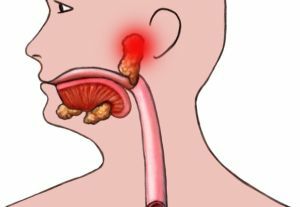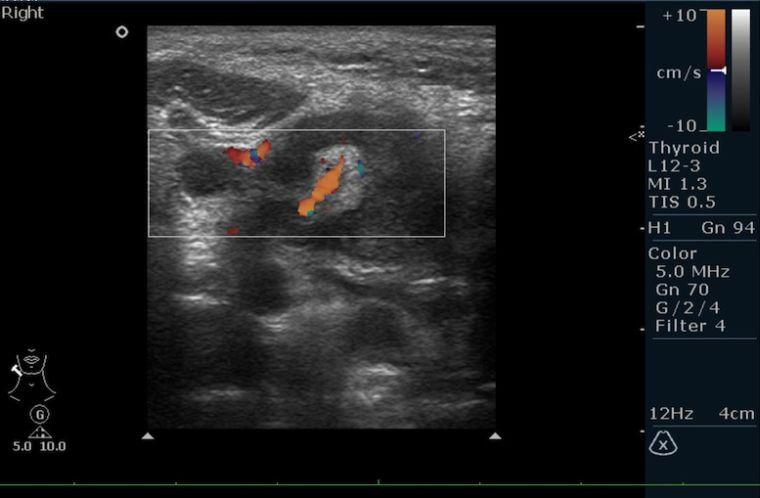 Sialosis( sialadenosis) is a chronic, recurrent, painless or slightly painful bilateral swelling of salivary glands that does not have inflammatory or tumor origin.
Sialosis( sialadenosis) is a chronic, recurrent, painless or slightly painful bilateral swelling of salivary glands that does not have inflammatory or tumor origin.
Often accompanied by hypoptialism( impaired saliva production) or asialia( no salivation).
Contents
- Causes
- Clinical picture
- Degrees of development
- Related diseases
- Diagnostic criteria
- Therapy and prognosis
Provoking causes
The factors contributing to the occurrence of sialadenosis are not completely understood, the disease can be allergic, immunogenic, hormonal or endocrine.
The most common cause of sialosis are systemic diseases, in particular, hormonal disorders, malnutrition or neurogenic disorders. These include:
- avitaminosis: pellagra, avitaminosis disease;
- diabetes mellitus;
- of uremia;
- endocrinopathy: hyperthyroidism;
- alcoholism;
- other hormonal disorders: menopause and andropause;
- diseases caused by malnutrition( eg, Kwashiorkor),
- cystic fibrosis.
The factor contributing to the manifestation of the disease is also the pregnancy and the use of certain medications.
Clinical picture of
Typical symptoms include: 
- pain in the salivary gland;
- changes in the nature, composition and amount of saliva;
- infringement of an innervation of a facial nerve;
- the main symptom is a change in the size of the salivary glands.
The increase in the size of the salivary glands can be classified as limited or diffuse, determined by visual and qualitative perception by palpation.
In the absence of bright pain symptoms, the patient addresses to a specialist engaged in the pathology of the salivary glands, mainly because of aesthetic / cosmetic changes in his appearance.
The etiopathogenesis of these diseases is rather complicated, the diagnosis is often determined only after a thorough lengthy medical examination.
Degrees of development
Three stages of the disease development are determined:
- salivary gland resizing can not be determined either visually or by palpation;
- a change in the size of the salivary glands can not be determined visually, however palpation indicates an increase;
- a change in the size of the salivary glands is determined, both visually and by palpation.
Related diseases
The following diseases are included in the scope of sialadenosis:
- Mikulich disease ( sarcoid sialosis) is a disease of unknown etiology, in which salivary, tearful and parotid glands slowly and painlessly increase.
- Syndrome Mikulich .Swelling of the salivary or lacrimal gland for known reasons( malignant tumors with significant involvement of the lymphatic system, chronic specific inflammation of the salivary glands, benign lymphogranulomatosis, affecting the salivary glands, toxic reaction to iodine, lead, mercury, and uremia).
- Sjogren's disease .The general dryness of the epithelial surfaces( dryness syndrome characterized by a triad of symptoms - xerostomia, dry keratoconjunctivitis, polyarthritis, as well as atrophy of the oral mucosa, increased tooth decay, pain in the corners of the mouth, smooth tongue, vulvovaginitis, xeroderma).There is a connection with other connective tissue diseases, retinal acidosis, lymphoma. Complications include pancreatitis, pleurisy, pericarditis, vasculitis, purpura, other collagenoses, thyroiditis and lymphoma.
- Syndrome of Kwashiorkor .The change in the size of the salivary glands is due to inadequate caloric intake, especially in the absence of proteins.

Sialosis of the right parotid gland on ultrasound
Diagnostic criteria
 First of all, a study is conducted by palpation.
First of all, a study is conducted by palpation.
The main task of differential diagnosis is to exclude the oncological nature of the increase in salivary glands. For this purpose, a CT scan is performed.
ultrasound is performed to determine the degree of salivary gland size change, decrease / increase in echogenicity. Saliva analysis helps to exclude the presence of an inflammatory agent.
Therapy and prognosis
Treatment of sialosis depends on the underlying provocative cause. In some cases, the elimination of factors that induce swelling of the salivary glands relatively quickly leads to relief of symptoms.
This applies in particular to people with eating disorders or with pharmacologically induced sialadenosis. In those cases where the main cause can not be eliminated( cirrhosis, endocrinopathy) or, if it is not established, therapy of the disease is quite complex and time-consuming.
 No exceptions are introduced to the regime measures and, paradoxically, sialogs( for example, Pilocarpine, over-the-counter acidic lozenges, chewing gum, etc.).These substances do not stimulate the glands to further hypertrophy; on the contrary, they help to release the retested zymogen granules.
No exceptions are introduced to the regime measures and, paradoxically, sialogs( for example, Pilocarpine, over-the-counter acidic lozenges, chewing gum, etc.).These substances do not stimulate the glands to further hypertrophy; on the contrary, they help to release the retested zymogen granules.
Surgical therapy is not applied, except for the extreme increase in salivary glands, which is a serious aesthetic defect.
The prognosis in case if it is possible to adequately control the main cause of the disease is quite good.
Sialadenosis is a benign disease with a good prognosis of quod vitam( for life) and a relatively good prognosis of quod sanationem( for cure).
From the physician's point of view, a wide differential diagnostic scale should be considered, since the swelling of the salivary glands may be caused not only by a wide range of causative factors, but also may be a symptom of a much more serious disease.
Everyone with a painless swelling of the salivary glands is required to be examined at a specialized center, since one of the first steps is to eliminate the oncological nature of the disease.
